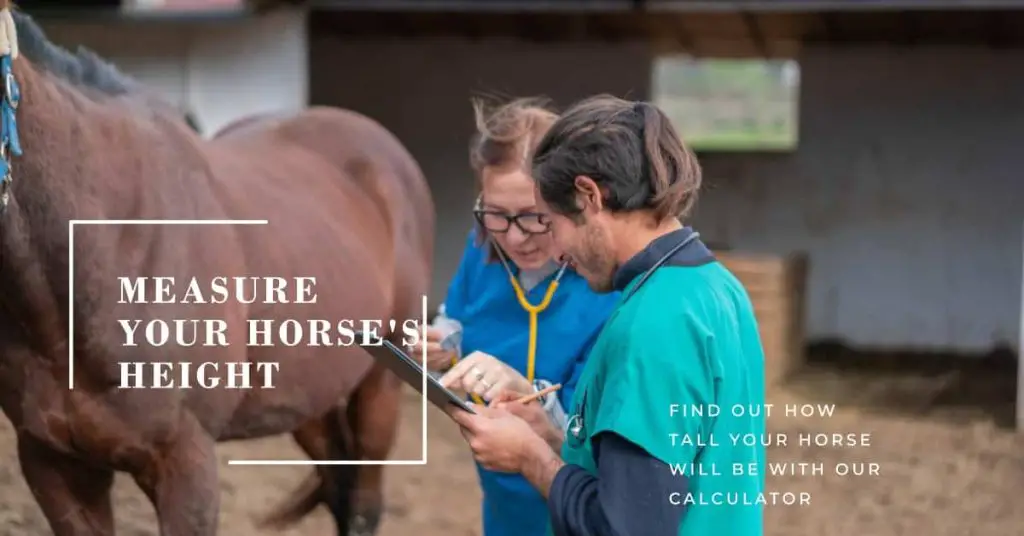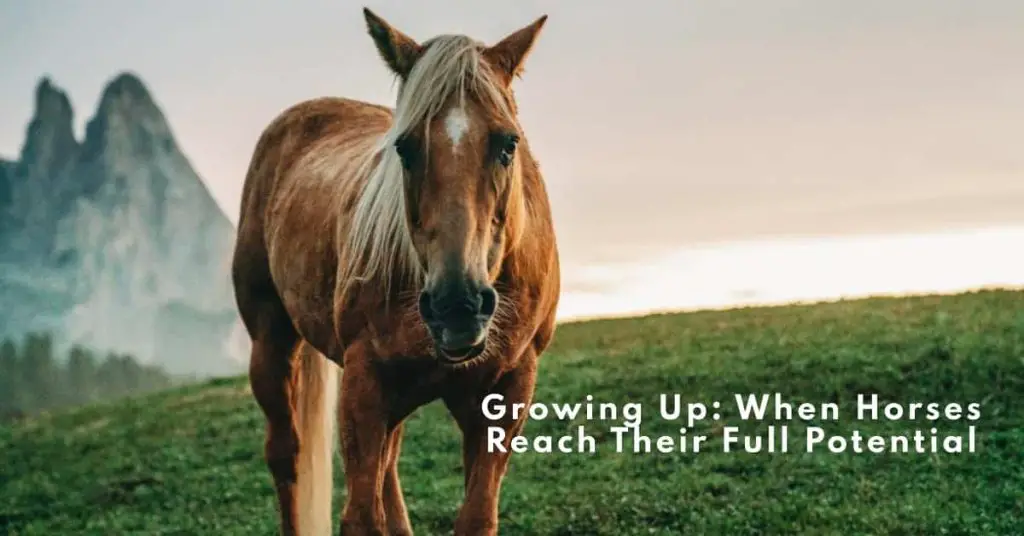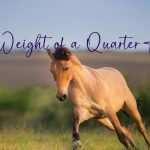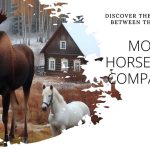When Does a Horse Stop Growing? A horse’s growth rate is largely determined by its breed and the amount of nutrition it receives. Generally, horses reach their full adult size between three and five years old. Foals typically begin growing rapidly in their first year and continue growing until they are about two years old; there may be some further growth after that, but it will usually be minimal.
After this point, a horse has generally reached 95% of its adult body size, though muscle development can still occur up to six or seven – especially if the animal is worked regularly.
In short, most horses stop growing around three to five years old; however, depending on genetics and diet, some individuals may take longer than others to reach full maturity.
A horse will typically stop growing around the age of four or five years old, although some breeds may reach full size at an earlier age.
At this point, it is important to provide proper nutrition and exercise in order to maintain soundness and health as your horse matures. It can be a challenging task to ensure that your horse has the right diet for his specific needs.
There are also certain supplements which can help support a healthy growth rate throughout these formative years. As with all animals, genetics is important in determining when a horse stops growing. So it’s important to ask questions about your animal’s pedigree before committing to ownership.
How Tall Will My Horse Be Calculator
If you’re curious about how tall your horse will grow to be, there’s a calculator that can help. It considers the breed and gender of your horse and its current height or age and then calculates an approximate adult size range for it.
This tool is useful for anyone who wants to know what their horse will look like when fully grown.

Will a 3 Year Old Horse Grow Anymore?
The answer to whether a three-year-old horse will grow anymore is an unequivocal yes. As horses are considered mature at five years old, a three-year-old horse still has two full years of growth ahead of them.
This growth can be seen in the form of not only height but also musculature and overall strength.
A good diet and proper exercise regime for your horse can help encourage healthy and balanced development during this time.
Additionally, when it comes to showing or race prep, training techniques such as longlining, ground driving, and lungeing may be recommended by your vet or trainer to help achieve desired results while helping prevent any potential injuries that could affect further growth.
Monitoring Your Horse’s Growth
It’s important to monitor and measure your horse’s growth regularly to ensure they are developing properly. Keep detailed records of their height, weight, body condition score, and other health metrics at different ages.
Compare these to breed standards and growth charts to identify potential issues early. Consult your vet if you have concerns about abnormal growth patterns. With careful tracking, you can stay on top of your horse’s development.
Providing Proper Nutrition for Growth
Nutrition is critical for supporting your horse’s growth and development. Their diet should contain ample protein, vitamins, and minerals to promote proper bone, muscle, tissue, and organ growth.
Feed quality hay and pasture along with a fortified feed designed for growing horses.
Avoid over or underfeeding. Consult an equine nutritionist if needed to formulate a diet plan tailored to your horse’s individual needs and growth goals. Proper nutrition will set up your horse for lifetime soundness and health.
Caring for Geriatric Horses
As horses reach their late 20s and 30s, they are considered geriatric and require specialized care. Their nutritional needs change as their body conditions decline.
Provide a high-quality senior feed, plenty of water, and free-choice hay. Monitor their weight closely. Regular dental care is essential. Arthritic joints may need supportive supplements. Increase hoof care as hooves become brittle.
Monitor for common age-related issues like Cushing’s disease. Adjusting their management will help ageing horses live comfortably through their golden years.
How Much Bigger Will a 2 Year Old Horse Get?
A two-year-old horse will usually grow until it reaches its full size and maturity at five. Depending on the breed, a two-year-old horse can be expected to gain another 4-8 hands in height and up to 200 pounds in weight over the next three years. During that time, they should also grow stronger as their bones harden and mature.
They should also experience some muscle development, especially in breeds used for racing or sports events. It’s important to provide your two-year-old with plenty of exercise and nutrition so they can reach their full potential when fully grown.
How Do You Tell How Big a Horse Will Grow?
To determine how large a horse will grow, there are several factors to consider. First, the breed of horse is important as certain breeds have a predetermined maximum size that they can grow to.
Secondly, age plays a role in determining size; typically, when horses reach their 3rd year of life, they have grown to 80% or more of their full-size potential.
Thirdly, nutrition and exercise play an important role in how big your horse might become–providing adequate nutrients and allowing for regular exercise will help ensure that your horse grows to its full potential size. Finally, genetics also play an incredibly large part in determining the final height of your equine friend; if both parents had been larger than average, then it is likely that their offspring may well be, too. On top of all this, remember that some horses may not reach the same level of maturity as others due to health issues or other conditions beyond anyone’s control.
However, with proper care and attention, you should get a good idea of how big your four-legged companion might eventually become!
What are the Stages of Horses Growth?
Horses are majestic, powerful creatures known for their grace and intelligence. They come in various sizes and colours, but all horses go through several stages of growth as they mature from foals to adults. The stages of horse growth include the newborn/foal stage, weanling stage, yearling stage and adult or mature stage.
During the newborn/foal stage, foals require special care from their mothers or handlers as they learn to walk within hours after birth. During this period, it is important for them to receive adequate nutrition so that their bones can develop correctly during this critical growing period.
Foals will also begin learning basic behaviours, such as responding to commands and becoming familiar with humans during this time.
The next major milestone in horse development occurs at around six months old when they enter the weaning process, separating them from their mother and transitioning them onto solid food sources such as hay or grain feed mixes.
This is an important step because it helps prepare them for life away from their family unit while teaching them how to survive on their terms without relying solely on milk production like most young animals do when firstborn into the world.
At one year old, horses enter what is known as the Yearling Stage, where physical changes occur rapidly, including increased muscle mass and bone density along with longer legs relative to body size compared with when they were younger foals just starting life’s journey in earnestness.
During this time frame, many owners may choose to engage in light-riding activities such as groundwork exercises. This helps build trust between rider and equine partner while providing valuable instruction about proper form before venturing onto trails together. Later, once both parties have built up the confidence levels necessary for safe outdoor outings together safely.
Finally, by three years old, most horses transition into adulthood (or “mature”), where further physical changes take place. Including full height attainment along with heavier weight gain due largely in part thanks to better diets supplemented by exercise routines designed specifically tailored towards each animal depending on its needs & goals.
Fourth, previously established by owner/trainer combo teams working hand-in-hand collaboratively towards mutual success achieved through hard work, dedication & commitment over long periods of timescale.
Investing heavily into developing strong bonds between man & beast alike, resulting ultimately positive outcomes no matter how big or small those successes may be defined individually moving forward!
The 5 stages of a horse life cycle
Conclusion
Overall, it is important to understand the growth rate of a horse in order to know when the animal will stop growing. Depending on its breed, age and gender, a horse can grow until 4 or 5 years old. While there are ways to influence their height by providing them with proper nutrition and exercise, ultimately, genetics play an important role in determining how large they will become.
Knowing this information can help you ensure your horse stays healthy and happy.
Janet G Kulick is an experienced horse rider, trainer, and owner of the informative horse blog, Horseray.com. Her engaging writing style and wealth of knowledge on horse care, riding, and training make her a trusted source for horse enthusiasts worldwide.






